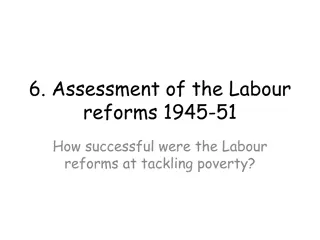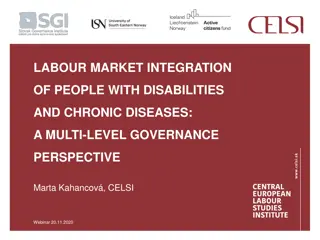Labour Market Participation in London Economic Region
Study findings reveal reasons for low participation rates in the London Economic Region, focusing on prime-age individuals and key barriers to entry. Factors such as skills mismatch, industrial shifts, and socioeconomic conditions play significant roles.
Download Presentation

Please find below an Image/Link to download the presentation.
The content on the website is provided AS IS for your information and personal use only. It may not be sold, licensed, or shared on other websites without obtaining consent from the author.If you encounter any issues during the download, it is possible that the publisher has removed the file from their server.
You are allowed to download the files provided on this website for personal or commercial use, subject to the condition that they are used lawfully. All files are the property of their respective owners.
The content on the website is provided AS IS for your information and personal use only. It may not be sold, licensed, or shared on other websites without obtaining consent from the author.
E N D
Presentation Transcript
Labour market participation in the London Economic Region Summary of findings August 9, 2021
Introduction The City of London and its partners engaged PricewaterhouseCoopers LLP ( PwC ) to conduct a study assessing the reasons for relatively low labour market participation in the London Economic Region (London ER). We have also identified considerations for various stakeholders in addressing low participation Our study was informed by: A web and phone survey, yielding 447 responses Secondary research and data Feedback from regional community partners Comments from the Advisory Committee and community stakeholders on report content This Employment Ontario project is funded in part by the Government of Canada and the Government of Ontario. The content and analysis presented in this report are not that of the Government of Canada or the Government of Ontario. 2
Londons prime-aged participation rate has lagged that of Ontario over the past decade This study focused mainly on prime- age individuals (25-54), who typically have the highest participation rate London CMA participation rates for prime-age individuals, 2005-2019 Factors that contribute to lower participation in London ER include mismatch between skills and available opportunities shifts in industrial activity poverty / low-income / health conditions 3
We assessed availability to participate for non-participant profiles To summarize the key drivers of non-participation in the London ER, we grouped non-participants into the following profiles. We note that there is overlap between the profiles, reflecting the intersection of different reasons why individuals choose not to participate in the labour market. Responses in survey % available to participate Non-participants in Potential participants in London ER London ER (2019)1 Total survey (15 years or older)2 447 52% - 69% 228,500 Prime-age non-participant profiles Total prime-age (aged 25-54) 249 65% - 86% 46,900 30,000 - 40,000 Women 145 65% - 88% 33,500 22,000 - 29,000 Visible minority 31 71% - 87% Indigenous up to 2,500 Immigrants 46 87% - 91% 9,300 8,000 - 8,500 With post-secondary education 3 179 72% - 87% 20,500 15,000 - 18,000 Without post-secondary education 70 47% - 81% 26,300 12,000 - 21,000 Health conditions 69 14% - 72% Low-income 99 63% - 90% Respondents aged 55-64 181 38% - 47% 30,100 4 12,000 - 14,000 1 Extrapolated using data from the Labour Force Survey and figures from the Local Employment Planning Council report London Economic Region Labour Market Participation (2017), and rounded to the nearest hundred. 2 Potential participants removed due to small sample size of respondents aged 15-24 and 65+ 3Includes all diplomas, certificates, and degrees beyond a high school education 4 For London CMA 4
A lack of attractive jobs are the top barriers to participation for prime-age respondents Top reasons for non-participation among prime-age respondents *Reasons for non-participation may not sum to 100% due to multiple response selections from respondents 5
Barriers that would need to be addressed include availability of attractive jobs and better access to services Factors that would need to change in order for prime-age respondents to participate *Reasons for non-participation may not sum to 100% due to multiple response selections from respondents 6
The study identified six key considerations in addressing low participation Several stakeholders have roles to play: Federal, provincial, and municipal/ regional governments 1 Mismatch between skills and available jobs 2 Health barriers Employers Childcare 3 Postsecondary, secondary, and elementary educational institutions 4 Flexibility Community organizations Access to transportation 5 Discrimination 6 7
Considerations require participation by government, educational institutions, employers and the community (1/2) For educational institutions For governments at all levels Increase funding and awareness for employment and training programs and agencies, with a focus on region- specific labour market opportunities Create apprenticeship and skills training programs in trades and other in-demand occupations Encourage employers to support participation through accommodation of disabilities, transportation options, and flexible work options Expand resources to improve mental and physical health for the community Increase efforts to promote cooperation with employers to increase the relevance of education for available jobs Expand labour market education and access to labour market information for elementary, secondary and post- secondary students Increase financial support to attend post-secondary and providing co-op / internship opportunities 8
Considerations require participation by government, educational institutions, employers and the community (2/2) For community organizations and employment agencies For employers Collaborate with academia and government to identify in-demand skills and jobs Participate in the development of employment programs Considering more competitive benefits such as work from home opportunities, flexible scheduling, child care benefits, and transportation support Work to increase accommodations for those with health conditions Work to address discrimination in workplaces Increase visibility of career counselling services Promote training opportunities Highlight recruitment activities from employers Showcase opportunities from employers in different industries to help job seekers understand the skills required in each Provide specialized training and upskilling programs for individuals with health barriers 9
Thank you pwc.com























